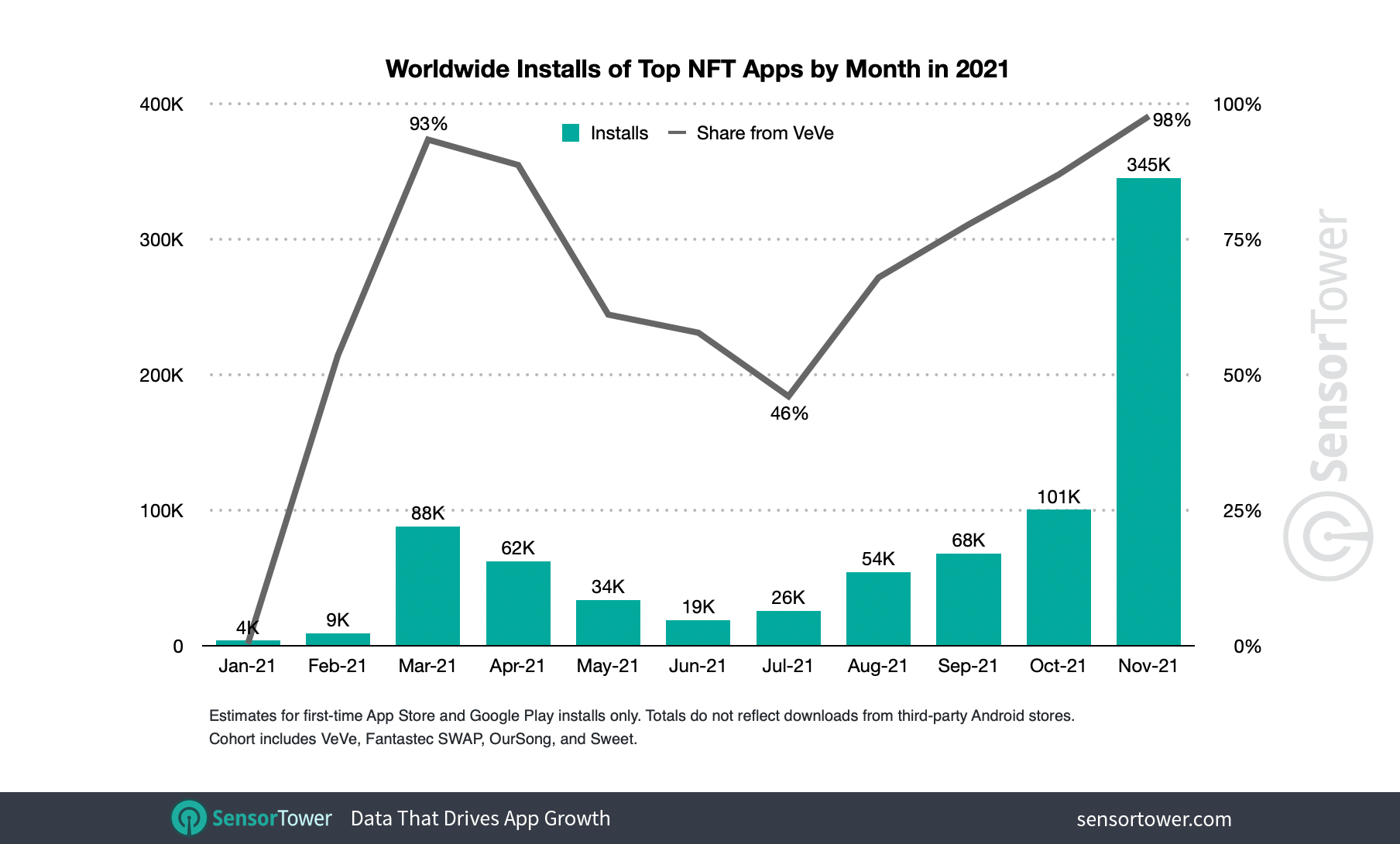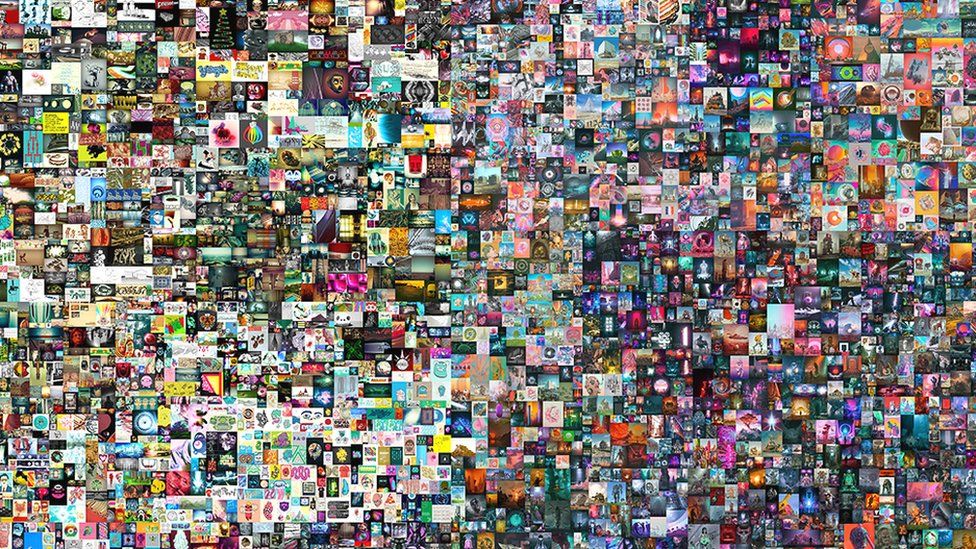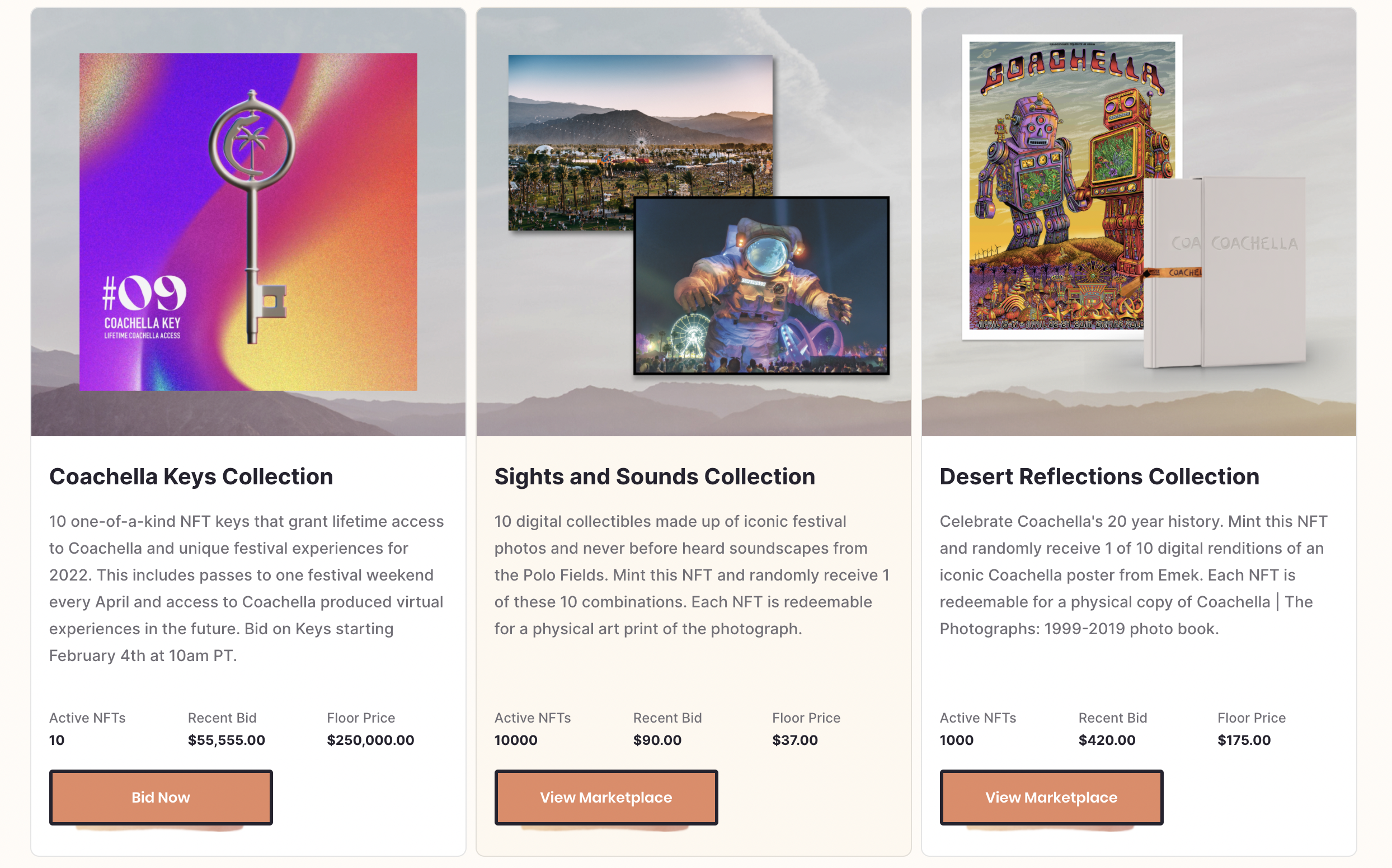Chances are you’ve heard the term “NFT'' thrown around in daily conversation. Although hearing NFTs, or non-fungible tokens, being talked about so regularly is fairly new to most of us, these digital assets have been around since 2014. Last year was the first year that this exciting technology broke through into mainstream media reaching $41 billion in value. The future of NFTs have disrupted the art world, music industry, real estate and mobile industries as well.
Source: SensorTower
These digital art pieces have been selling for record breaking amounts in the last year. What’s thought of as the first ever NFT was created by Kevin McCoy in 2014 and sold for $1.4 million in 2021. This number is nothing compared to the $69 million paid for Beeple’s “Everydays: The First 5000 Days”. The list goes on with Matt Hall’s “Crypto Punks” series each selling for over $7 million and Pak’s ‘The Merge’ at $91.8 million (possibly the most expensive NFT ever sold).
“Everydays: The First 5000 Days, Beeple. Source: Dexerto
These staggering numbers beg the question – why put so much money into intangible items that are essentially, available for the world to access? (For example, accessing Beeple’s famous NFT pictured above.) In short, they are changing the way consumers buy and sell assets, and it is pivoting many industries along with its adoption.
What is an NFT?
An NFT, or non-fungible token, is a digital asset that represents real-world objects such as art, collectables, games and music. They are, essentially, collector’s items that have been digitized and sold online. As the name “non-fungible token” suggests, each NFT is a unique, one-of-a-kind digital item. NFT’s are frequently bought and authenticated with cryptocurrency, meaning that every transaction is recorded on a blockchain – similarly to how crypto is tracked. The blockchain maintains a tamper-resistant record of transactions and keeps track of who owns what.
The main impact of NFTs is that it makes buying and selling digital content much easier and trackable. Before NFTs, artists wishing to sell their work online had trouble monetizing their art directly because consumers could just download or screenshot for free. By creating an NFT, creators are able to verify scarcity and authenticity of anything digital. To compare this system to a more traditional way of collecting art: there are endless copies of the Mona Lisa but only one original piece. The technology behind NFTs helps to assign ownership of original pieces of digital art.
Buying NFTs
There are numerous ways to buy and sell NFTs and although the most popular platforms are still web-based, the exchange of these digital assets may be slowly migrating to mobile apps.
OpenSea is arguably the internet’s most popular NFT marketplace with a market value of $13 billion. OpenSea provides a simple interface for users to list, browse and bid on tokens without having to interact directly with the blockchain. However, with this booming growth brings a cartload of headaches as OpenSea has struggled to keep up with emerging security incidents and endless copycat NFTs. Most recently, there was an attack on OpenSea with hundreds of NFTs stolen that were valued at more than $1.7 million.
OpenSea launched their first app in September of 2021 and by January already had over 2 million users on their app. However, the app is not meant for the buying and selling of NFTs but rather for browsing purposes only. This leaves a huge space in the market for apps to sell these digital assets. Market opportunity for NFT trading apps is growing as interest and usage increase, with not much competition so far. When will the app market offer the best apps for trading NFT’s? When will the NFT app market catch up with demand?
Apps and NFTs
With not much competition, it's hard to say what is the best app for NFT trading currently. However, the most recent app to dip it’s toe into the NFT waters is VeVe. VeVe is an app-based marketplace for premium licensed digital collectibles, aka NFT app marketplace. VeVe initially launched in 2018 and had slow but steady growth since its inception. In November of 2021, VeVe partnered with Disney to create limited edition Disney Golden Moments NFTs, resulting in the most downloads in a single day for VeVe's mobile app on the collection's drop day on November 9. Worldwide installs reached 39,000 on that day – up nearly five times from approximately 8,000 installs on November 2nd. VeVe saw $4.4 million in consumer spending on Disney+ Day (November 12th) – the most the app has generated in a single day.
This example has no doubt sparked the fire for other apps to join in on the NFT app goldmine. Shopify, a commerce platform that lets you start, grow, and manage a business, announced in July of 2021 that they will be implementing the exchange of NFTs through their website as well as their app. Apps such as GoArt and Dream by WOMBO have been created to help consumers make their own NFTs. Both these apps have seen tremendous growth (over 800% increase in users to be exact) within the last three months due to the increased popularity of NFTs.
Although mobile apps aren’t the most popular way to buy and sell digital assets, NFT trading apps are likely to make their way into the app universe just like cryptocurrency transitioned into the mobile space.
The Future of NFTs
Right now, the majority of NFTs are used to sell digital art and collectibles.he future of NFTs is advancing over time and we are seeing sports and concerts jump into the mix by selling NFTs that give lifetime access to events or festivals.
Coachella recently announced the launch of three NFT collections: Sights and Sounds, Desert Reflections, and Coachella Keys. On their own native marketplace, consumers can purchase a range of digital photos, soundscapes, and posters that can be redeemed for real-world experiences. Centurify is another company that is using NFTs to help fans connect with their favorite musicals through buying digital merchandise and tickets to exclusive, live events.
Source: Coachella
Even events as big as the Super Bowl are getting in on the NFT craze. This year the Super Bowl issued NFT tickets to attendees, thereby distributing non-fungible assets to a brand new cross section of society to bring NFTs from being futuristic technology to present day 2022. The Super Bowl partnered with Ticketmaster to give all attendees access to claim their very own NFT ticket. This digital keepsake will live on long after the physical ticket stubs have turned to dust.
Sports and concerts aside, non-fungible tokens can be extremely valuable for business ownership, intellectual property rights and real estate deeds. As NFTs contain code with a unique set of information, they can be used to tokenize documentation such as degrees, academic certificates, licenses and other qualifications as well as medical records, birth and death certificates. This concept could be applied to driver's licenses or passports in the future, or could even be considered a viable recourse to display covid vaccine documentation sooner than we think. In the future, NFTs could help eliminate the need for physical driver's licenses,take away risk of visa,passport, or vaccine card forgeries.
NFTs & Advertising
With the adoption of NFT's, the app space stands to grow to meet this new trend. Currently, the app store has a limited offering of NFT trading apps. While this may be a challenge due to privacy constraints and high royalty fees collected by the Apple Store and Google Play, the opportunity for market share in this area is palpable.
Fintech apps dedicated to investment, trading and cryptocurrency have surged in recent years. With more people than ever using mobile apps to engage in digital trading, NFT marketplace apps have also seen an uptick. There’s also an opportunity for publishers and advertisers to monetize this emerging niche app ecosystem. Furthermore, with tracking and data privacy concerns on the rise, using NFTs and blockchain authentication technology to enhance transparency and security could go hand-in-hand.
Needless to say, the term “NFT” isn’t leaving our vocabulary any time soon – with numerous new industries creating their own way to leverage this technology. There is significant room in the market for NFT apps to be the go-to method of buying and selling these digital assets and the pay off for those at the forefront is sure to be nothing short of extravagant.
Takeaways on the Future of NFTs & Apps
Although the phrase “NFT” is stamped all over headlines, a lot of people still don’t have a basic understanding of what an NFT actually is (don’t worry, you’re not alone!) NFTs, or non-fungible tokens, are digital assets that represent real-world objects such as art, collectables, games and music.
- Buying NFTs - There are numerous ways to buy and sell NFTs and although the most popular platforms are web-based, the exchange of these digital assets may be slowly migrating to mobile apps.
- NFTs and Apps - VeVe is the most recent app to facilitate the purchases of NFTs. In November of 2021, VeVe partnered with Disney to create limited edition Disney Golden Moments NFTs, resulting in the most downloads in a single day for VeVe's mobile app on the collection's drop day on November 9.
- NFTs and Advertising - Opportunity to be first mover in this space, to generate new ad campaign ecosystems, monetization techniques and targeting capabilities built with blockchain tracking.
- Future of NFTs - Currently, the majority of NFTs are used to sell digital art and collectibles. However, we are starting to see sports and concerts jump into the mix by selling NFTs that give lifetime access to events or festivals. For example, Coachella recently announced the launch of three NFT collections. 🎡




